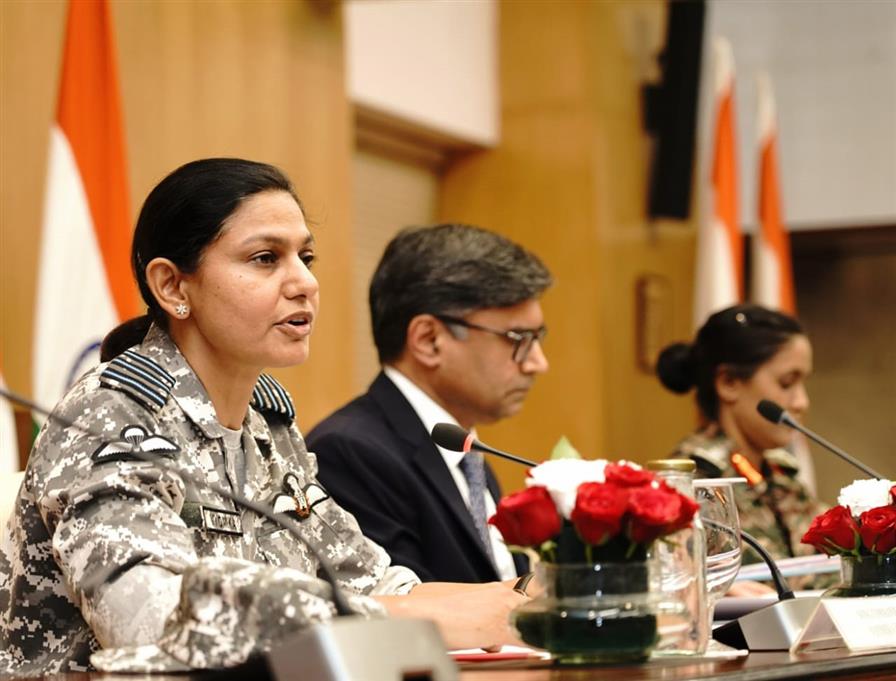India did not mention any US intervention even as American President Donald Trump claimed US mediated the ceasefire. Contradictions galore over US's claims that India and Pakistan have agreed to hold talks.
Published May 10, 2025 | 8:59 PM ⚊ Updated May 10, 2025 | 8:59 PM

Wing Commander Vyomika Singh, External Affairs Secretary Vikram Misri, and Colonel Sofiya Qureshi at an earlier joint press conference, briefing the media about Operation Sindoor. (PIB)
Synopsis: Indians were aware of the ceasefire even before the government officially announced it, indirectly saying that Pakistan blinked first. Questions, however, remain. How did the US announce it before India? What was the deal?
India’s announcement of the ceasefire was brief, measured, and devoid of any emotion.
The US, starting with President Donald Trump, raved about that country’s mediation in bringing about “a full and immediate ceasefire” between the armed forces of India and Pakistan. However, India did not mention the US in either of the two press conferences.
India’s Minister for External Affairs S Jaishankar, who made a separate statement on X, said India and Pakistan worked out an understanding on the stoppage of firing and military action.
He did not mention the US’s intervention, but warned that India would continue to maintain a firm and uncompromising stance against terrorism in all its forms and manifestations.
External Affairs Secretary Vikram Misri furnished a little more detail. The Director General of Military Operations of Pakistan called his Indian counterpart at 3.35 pm on Saturday, and both sides agreed to “stop all firing and military action on land, air, and sea with effect from 5 pm, Indian time, he said.
Defence personnel Commodore Raghu R Nair, Colonel Sofiya Qureshi, and Wing Commander Vyomika Singh, however, did not mention the behind-the-scenes.
Instead, they punched holes in Pakistan’s disinformation campaign. Commodore Nair said the Indian Army, Navy, and the Air Force have been instructed “to adhere to this understanding” reached to end all military activities. He did not explain further.
US Secretary of State Marco Rubio said the engagement with Indian and Pakistani officials and governments extended for 48 hours.
“Over the past 48 hours, @VPVance and I have engaged with senior Indian and Pakistani officials, including Prime Ministers Narendra Modi and Shehbaz Sharif, External Affairs Minister Subrahmanyam Jaishankar, Chief of Army Staff Asim Munir, and National Security Advisors Ajit Doval and Asim Malik,” he said on X before announcing the ceasefire agreement the governments of Indian and Pakistan have arrived at.
Rubio also said the rival governments have also agreed to “start talks on broad set of issues at a neutral site”.
India’s Ministry of Information and Broadcasting contradicted Rubio. It said the ceasefire decision was made “directly” by the two countries.
“The Pak DGMO initiated the call this afternoon after which discussions took place and understanding reached.
There is no decision to hold talks on any other issue at any other place,” it said catergorically.
.@MEAIndia announces that stoppage of firing & military action between India and Pakistan was worked out directly between the two countries.
The Pak DGMO initiated the call this afternoon after which discussions took place and understanding reached.
There is no decision to… pic.twitter.com/HrepAj12bR
— Ministry of Information and Broadcasting (@MIB_India) May 10, 2025
US Vice-President JD Vance, who earlier said on record that the India-Pakistan conflict was “fundamentally none of our business,” was quick to congratulate the President’s team, “especially Secretary Rubio” after the United States announced the ceasefire between the two Asian neighbours.
“Great work from the President’s team, especially Secretary Rubio,” he tweeted. “And my gratitude to the leaders of India and Pakistan for their hard work and willingness to engage in this ceasefire.”
The US’s role in containing the conflict that looked like heading towards a full-blown war between two nuclear powers is not immediately known. India, so far, is tight-lipped.
But in this information age in which news spreads at the speed of a button’s click, India was aware of the ceasefire before its government officially announced it, because the US had already declared it, and claimed credit.
Questions remain: How did the US announce the ceasefire first? What made India and Pakistan decide to talk? Only time could tell.
